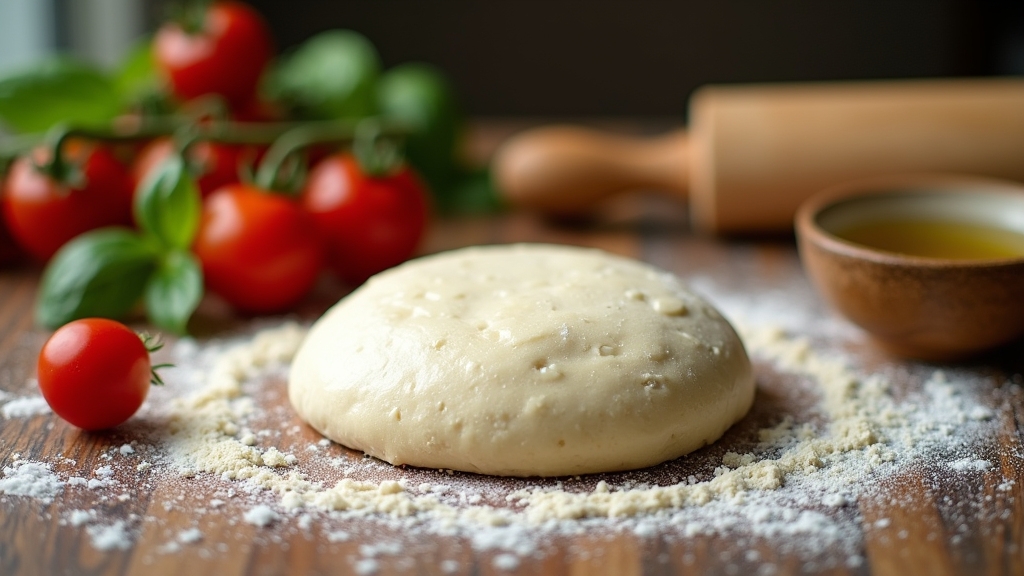Making simple pizza dough from scratch is easier than you might think! I just mix warm water and yeast, then gradually add flour to create a sticky dough. After kneading it into a smooth texture, I let it rise to develop flavor. I can shape it into my preferred style, whether thin or thick crust. The possibilities for toppings are endless, and there’s so much more to explore in crafting the perfect pizza experience!
History
When I plunge into the history of pizza dough, I can’t help but marvel at its evolution from humble beginnings to a global favorite. Its ancient origins trace back to the flatbreads enjoyed by various cultures, including the Egyptians and Greeks, who used simple ingredients to create sustenance. As I explore further, I realize how pizza dough signifies more than just food; it embodies cultural significance, showcasing regional flavors and traditions. Each twist and fold tells a story of innovation, merging local ingredients with culinary creativity. From Naples’ classic Neapolitan to the deep-dish varieties of Chicago, pizza dough continues to adapt, reflecting our ever-changing tastes while uniting us in our love for this cherished dish.
Recipe
Making pizza dough from scratch is a rewarding experience that allows you to customize your pizza exactly to your liking. The key to a great pizza dough lies in using high-quality ingredients and giving it the proper time to rise. This dough is versatile and can be used for various types of pizzas, whether you prefer a thin crust or a thicker, chewier base. Once you master this recipe, you’ll never want to reach for a store-bought option again.
The process is straightforward, and with just a bit of patience, you can create a delicious crust that will serve as the foundation for your favorite toppings. The dough requires minimal ingredients, and the most essential element is time; allowing the dough to rise properly will result in a lighter, airier crust. So roll up your sleeves and get ready to impress your friends and family with homemade pizza!
Ingredients:
- 2 ¼ teaspoons active dry yeast
- 1 teaspoon sugar
- ¾ cup warm water (about 110°F)
- 2 cups all-purpose flour
- 1 teaspoon salt
- 1 tablespoon olive oil
To make the pizza dough, start by activating the yeast. In a small bowl, combine the warm water, sugar, and yeast. Let it sit for about 5-10 minutes until it becomes frothy. In a large mixing bowl, combine the flour and salt. Once the yeast mixture is ready, add it to the flour along with the olive oil. Stir until a dough begins to form, then knead it on a floured surface for about 5-7 minutes until it becomes smooth and elastic. Place the dough in a lightly greased bowl, cover it with a clean kitchen towel, and let it rise in a warm area for about 1 hour, or until it doubles in size.
For best results, consider these tips: Use high-quality flour for the best texture and flavor. If you prefer a more flavorful dough, you can let it rise in the refrigerator overnight for a slow fermentation, which will enhance the taste. Additionally, make sure your water is at the right temperature to guarantee that the yeast activates properly. When you’re ready to shape your dough, be gentle to retain the air bubbles formed during the rise, as these contribute to a light and airy crust. Happy pizza making!
Cooking Steps
Let’s get started with the cooking steps that will bring your pizza dough to life! First, I mix warm water with yeast to awaken those tiny organisms, and then I gradually add flour to create a rich, sticky combination. As I knead the dough until it’s smooth, I can already imagine the delicious pizza that awaits!
Step 1. Mix Warm Water and Yeast
To kick off the pizza dough-making process, I start by mixing warm water and yeast in a bowl. The key here is to get the water temperature just right—ideally around 110°F (43°C)—to guarantee proper yeast activation. I gently stir the mixture, allowing the yeast to dissolve and awaken, creating a bubbly froth that signals it’s ready to work its magic. Here’s what I keep in mind:
- Use filtered water for a cleaner taste.
- A pinch of sugar can boost yeast activation.
- Make sure the bowl is warm to the touch.
- Let the mixture rest for about 5-10 minutes.
- A little patience goes a long way in developing flavor!
This initial step sets the foundation for a delicious pizza crust.
Step 2. Add Flour Gradually
As the yeast mixture starts to bubble, I gradually add flour, ensuring it incorporates smoothly without any lumps. I prefer using a mix of all-purpose and bread flour types for that perfect balance of flavor and texture. Each scoop of flour brings the dough to life, transforming it into a sticky mass that requires careful attention. I watch closely as the dough consistency shifts, becoming smoother and more elastic with each addition. It’s essential to monitor this stage; too little flour leaves it gooey, while too much makes it dry. I keep mixing until I reach that ideal point where the dough feels soft yet holds its shape. This gradual addition is key to achieving the perfect pizza crust.
Step 3. Knead Dough Until Smooth
With the dough now forming a cohesive mass, it’s time to knead it until smooth. This is where the magic happens, and I can already feel the dough becoming more elastic under my hands. I use a combination of kneading techniques to guarantee it’s well-developed:
- Press down with the heel of my hand
- Fold the dough over itself
- Rotate it a quarter turn
- Repeat the process for about 8-10 minutes
- Keep a light dusting of flour handy
As I knead, I notice how the dough transforms, becoming silky and pliable. This step is vital for achieving that perfect pizza crust, allowing it to rise beautifully and hold its shape. Now, let’s get ready for the next stage!
Step 4. Let Dough Rise Covered
Now that I’ve kneaded the dough to perfection, it’s time to let it rise. I cover the bowl with a damp cloth, creating a cozy environment for the dough. This step is essential; it allows the dough to undergo its fermentation process, enhancing flavor and texture. As the yeast works its magic, the dough hydrates, absorbing moisture and expanding. I find a warm spot in my kitchen—an ideal temperature encourages yeast activity and results in a beautifully risen dough. After about an hour, I peek under the cloth, and I’m greeted by a fluffy, doubled-in-size masterpiece. This is where the alchemy happens, turning simple ingredients into something extraordinary, ready for the next phase of my pizza-making adventure.
Step 5. Shape Dough Into Balls
After the dough has risen to its fluffy perfection, I gently punch it down to release the air and then turn it out onto a floured surface. It’s time to shape the dough into balls! I divide the dough into equal portions, about the size of a golf ball, ensuring each piece has a consistent dough texture.
- Use your palms to roll the dough into perfect spheres.
- Lightly flour your hands to prevent sticking.
- Allow the dough balls to rest for 10-15 minutes.
- Experiment with different portion sizes for unique pizzas.
- Keep them covered with a damp cloth to maintain moisture.
These steps will set you up for pizza success, creating a delightful base for your favorite toppings!
Nutritional Guide
Understanding the nutritional aspects of pizza dough is essential for anyone looking to balance flavor with health. When I create my pizza dough, I’m always mindful of the calorie count and ingredient benefits. Each ingredient plays a role, contributing not just to taste but also to nutrition.
Here’s a quick table to help you visualize the nutritional value:
| Ingredient | Benefits |
|---|---|
| Whole Wheat Flour | Higher in fiber, aids digestion |
| Olive Oil | Heart-healthy fats, supports good cholesterol |
| Yeast | Natural leavening, provides B vitamins |
Final Thoughts
As I reflect on my journey of perfecting pizza dough, I realize how each ingredient and technique can transform a simple meal into a delightful experience. Embracing various dough variations has opened my eyes to endless possibilities. Here are a few insights that have inspired me:
- Experiment with whole wheat or gluten-free options for healthier alternatives.
- Infuse herbs and spices into the dough for an aromatic twist.
- Play with different hydration levels to achieve your desired texture.
- Pair seasonal, fresh pizza toppings to enhance flavors.
- Don’t shy away from unconventional toppings; creativity is key!
Ultimately, each pizza I make tells a story, blending tradition with innovation, and I can’t wait for you to begin your own pizza-making adventure!
Frequently Asked Questions
Can I Use Whole Wheat Flour Instead of All-Purpose Flour?
You can definitely use whole wheat flour instead! I love its nutritional benefits, plus it gives the dough a heartier texture. Just remember, it may require a bit more hydration for the perfect rise.
How Long Can I Store Unused Pizza Dough?
I’ve found that I can store unused pizza dough in the fridge for up to three days. For longer pizza dough storage, I freeze it, extending its shelf life to about three months—perfect for spontaneous pizza nights!
Can I Freeze Pizza Dough for Later Use?
Absolutely, I freeze my pizza dough for later use! For best results, I wrap it tightly in plastic and label it with the date. These freezing tips guarantee fresh dough storage that’s ready when inspiration strikes!
What Is the Best Way to Roll Out Pizza Dough?
When I roll out pizza dough, I use a lightly floured surface, ensuring even dough thickness. I start from the center, gently pushing outward, perfecting my topping techniques for a deliciously innovative pizza experience.
How Can I Make Gluten-Free Pizza Dough?
I love experimenting with gluten-free pizza dough! I mix various gluten-free flours like almond and coconut, then add creative pizza topping alternatives, ensuring a delightful, unique flavor that everyone can enjoy, regardless of dietary restrictions.
Conclusion
As I wrap up this simple pizza dough journey, I can’t help but share that Americans consume about 3 billion pizzas each year—now that’s a slice of life! Making your own dough not only connects you to this rich history, but it also opens up a world of flavors right in your kitchen. So, roll up your sleeves, get creative, and let the aroma of fresh dough transform your home into a pizzeria. Happy baking!

Simple Pizza Dough Recipe
Ingredients
Equipment
Method
- Activate Yeast: In a large bowl, dissolve sugar in warm water. Sprinkle yeast over the water and let sit for 5–10 minutes until frothy.
- Mix Dough: Add flour, olive oil, and salt to the yeast mixture. Stir with a spoon until a shaggy dough forms.
- Knead: Turn dough onto a floured surface and knead for 5 minutes until smooth and elastic. Add flour as needed to prevent sticking.
- First Rise: Place dough in a greased bowl, cover with a towel, and let rise in a warm place for 1 hour or until doubled in size.
- Shape: Punch down dough, divide into 2 balls, and roll out on a floured surface to desired thickness.
- Top & Bake: Add sauce and toppings, then bake at 475°F (245°C) for 12–15 minutes until crust is golden.
Notes
- For Crispier Crust: Preheat a pizza stone or baking sheet before baking.
- Make-Ahead: Refrigerate dough for up to 24 hours (punch down if it over-rises).
- Gluten-Free: Substitute 1:1 gluten-free flour blend (add 1 tsp xanthan gum).

